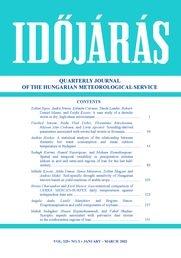IDŐJÁRÁS - angol nyelvű folyóirat
Vol. 125, No. 1 * Pages 1–166 * January - March 2021
 |
|
 letöltés [pdf: 8791 KB]
letöltés [pdf: 8791 KB]
A case study of a derecho storm in dry, high-shear environment
Zoltán Sipos, André Simon, Kálmán Csirmaz, Tünde Lemler, Robert-Daniel Manta, and Zsófia Kocsis
DOI:10.28974/idojaras.2021.1.1 (pp. 1–37)
Zoltán Sipos, André Simon, Kálmán Csirmaz, Tünde Lemler, Robert-Daniel Manta, and Zsófia Kocsis
DOI:10.28974/idojaras.2021.1.1 (pp. 1–37)
IDŐJÁRÁS folyóirat

Az IDŐJÁRÁS a HungaroMet Nonprofit Zrt. negyedévenként megjelenő angol nyelvű folyóirata
Megrendelhető a journal.idojaras@met.hu címen.
A szerzőknek szánt útmutató itt olvasható.
Megrendelhető a journal.idojaras@met.hu címen.
A szerzőknek szánt útmutató itt olvasható.









